for Female Inebriates
Rehabilitation (Protestant female inebriates). Later, children's home.
The 180-acre Duxhurst estate, lying between Reigate and Horley, was chosen as the site for the home. It already contained a Manor House and a farm, so could be put to use almost immediately. The estate was secured on a long lease by the British Women's Temperance Association and the Industrial Farm Colony opened in 1895.
The Colony was formally opened on 6th July 1896 by Princess Mary, Duchess of Teck. Initially it would accommodate 40 patients, who were expected to stay at least one year. They would be treated both medically and spiritually. Since the nearest seller of alcohol was a mile and a half away, they would be isolated from the temptations of the outside world.
Although all classes of inebriates were accepted, they were housed separately.
The main building, the Manor House, known as the Sanitorium, had been built as a gentleman's residence and was surrounded by extensive gardens and grounds, with fine views and good healthy air. It accommodated aristocratic ladies and stage celebrities suffering from alcoholism or narcotism. The weekly charges varied from 2 to 5 guineas (£2.10 - £5.25).
About a mile away from the Sanitorium was Hope House, which received inebriates of the middle-classes, who paid a lower rate - a maximum of 30 shillings (£1.50) a week.
A third home - also at a convenient distance from the Sanitorium - admitted poor and destitute inebriates of the working classes. These patients lived in single-storey purpose-built thatched cottages (six of which had been built by 1896), arranged around three sides of a village green. (The recidivist alcoholic Jane Cakebread (1827-1898) was accommodated here for a while, but Lady Isabella was forced to eject her when she proved to be too disruptive. This action brought the Colony's methods briefly into disrepute and ridicule. Jane Cakebread, who had acquired 281 convictions for drunkenness, finally died of cirrhosis of the liver in Claybury Asylum.) Each cottage was named individually, either after a female saint - St Ann's, St Hilda's, St Bridget's - or after the sponsors who had contributed funds to its building - the Birmingham Cottage, funded by the Birmingham Central Union, the Massingberd Cottage, in commemoration of the marriage of the son of that family, the Derby Cottage, after the Derby branch of the British Women's Temperance Association, Weston Cottage, after Bishop Frank Weston, Archbishop of Zanzibar, who had consecrated part of the chapel, and Isabel Cottage, after Lady Isabella, funded by the British Women's Temperance Association. These patients paid 5 shillings (£0.25) a week.
Each cottage accommodated 6 patients under the care of a nurse-sister (usually recruited from the Church Army). A large main building along one side of the green contained the dining and recreation room, the kitchen, and the weaving and workrooms; it was named Margaret Bright Lucas, after the reformer whom Lady Isabella had succeeded as the President of the British Women's Temperance Association.
Babies under the age of 15 months were also welcomed with their mothers into the Colony. They were cared for in a holiday home close to the cottages, called The Nest, a long low building near the entrance to the Colony.
The Nest also provided a two-week break for children, many of them maimed, selected periodically from the slums of London (utter destitution was the only criterion for such a holiday, which was all too brief). To nurture the patients' maternal instincts, orphans were brought from the Society for the Prevention of Cruelty to Children and The Nest began to develop into a permanent home for children who had been abused by their parents in a state of inebriation.
The Colony had its own hospital, where each new patient was assessed at admission, before being transferred to her final accommodation.
A chapel was built in the centre of the village. Dedicated to St Mary and the Angels, its external appearance was of rustic simplicity. The interior, however, was beautifully decorated with pictures and icons brought back by Lady Isabella from her travels abroad. A splendid organ was installed.
Lady Isabella herself also lived on the estate, in a rather substantial thatched house named The Cottage at the south of the site. She devoted her remaining years to the Colony, working with the patients and usually wearing a nurse's uniform.
The women were taught skills which would be useful to them when they left the Colony. They were paid for their employment and a careful account was kept of their earnings. Once the weekly charges for their keep had been deducted, the remainder was held in safe-keeping for them until they were discharged.
Lady Isabella disapproved of the passive occupations provided in prison for female inmates, such as needlework. She believed that outdoor physical activities were more important for the healing of mind and body. A dairy farm had been established in May 1896. Poultry-rearing and bee-keeping also provided work, as did workroom industries, such as weaving, basket-making and pottery.
Extensive glasshouses had been built behind the Sanitorium and a trained lady gardener was employed to teach the inmates gardening skills. The women worked in the gardens, greenhouses and in the estate's extensive lavender fields. Large fruit gardens - strawberry beds and raspberry canes - were planted out by them and, when ripe, the fruit was picked and made into preserves. In the summer they clipped the hedges; grass was mown and made into hay. Dairy products and honey were sold. Other domestic industries included knitting, sewing and embroidery (many items were made for the chapel).
Study and recreation were not neglected, and classes were held in the recreation hall in the evenings.
By 1897 the Colony had 50 beds.
Following the Inebriates Act, 1898, the Colony was licensed to receive 12 inebriates under the Act, usually of a 'lower class' sent by the courts as an alternative to prison.
In 1899, after four years of operation, of the 112 women who had been discharged, some 55 (almost 50%) were doing well. More buildings had been added to the site (eventually some 75 to 80 patients could be housed.) In 1900 there were 64 inmates, of whom 48 were married and 16 single. The majority (29) drank spirits alone, while 15 drank beer and malt liquors; 11 drank any form of alcohol, 4 drank beer and wine, and one took opium.
In 1902 the Medical Officer for the Colony claimed a 45% success rate in the cure from alcoholism.
During WW1, on 20th July 1915, the Sanitorium was commandeered by the War Office for use as a Red Cross Hospital. It had 100 beds and was affiliated to the Horton (County of London) War Hospital. The inmates of the Colony were discharged or sent elsewhere, but the qualified nursing staff were kept on to nurse the convalescent servicemen.
In 1917 the Red Cross Hospital was decommissioned and returned to the Colony. However, the need for such an institution was much reduced. Because of the war, work was now available for women, reducing the unhappiness and loneliness many had relieved by drink. Restrictions on opening times for public houses also decreased temptation. Lady Isabella decided to make the Colony into a home for children - the Duxhurst Children's Village.
Babies were accommodated in the Manor House, now known as the Babies' Haven. They were illegitimate, fathered by servicemen, some of whom had been killed in the war before they could marry the mother, although many of the mothers had no idea where the fathers were. Mothers would leave their babies, safe in the knowledge they would be well looked after, and return to work. In some cases the mothers stayed with their babies, working on the estate or as domestics in the Manor House itself. Mothers paid 5 shillings (£0.25) a week for their babies, but had to furnish the name of a guarantor in case the money was not paid.
In August 1917 there were 52 children, varying in age from 10 days old to two years. Whenever the weather allowed, babies were left in their wicker cots in front of the house to lie in the fresh air. Toddlers were allowed to run around barefoot.
The nursing staff consisted of a Day and a Night Sister, two qualified nurses, three nursery nurses and a nurse maid. Each 'family' of 8 children was looked after by one nurse. They were fed at 07.00, then had lunch at 10.00 (after which, on fine days, they went outside in the fresh air), dinner was at 12.00 noon, tea at 15.30 and supper at 18.00. Babies were bottle-fed every three hours, using whole milk from the estate's shorthorn cows.
In addition, St Ann's Cottage, with 5 beds, was used by patients from Queen Charlotte's Hospital, who came there with their babies to convalesce.
At the age of 3 years, the children moved to The Nest where schooling was given and, in due time, employment was found for them.
Lady Isabella died at the age of 71 years in
London in March 1921
after a short illness. The Children's Village, in financial
difficulties, finally closed in 1923.
Present status (September 2012)
In October 1923 the buildings reopened as the Princess Marie Louise Village for Gentlefolk, a home with accommodation for 44 ladies fallen on hard times. It was run until the mid 1930s by Miss Gertrude Margaret Carew Cass, who had been the second-in-command at Duxhurst, and had invested her savings in the scheme. She lived in The Cottage until her death in 1958.
In April 1928 the Manor House was rented temporarily to house the High Trees School, whose own building had been destroyed by fire.
At the end of October 1936 the estate was advertised for sale, but there were no takers until 1938, when it was purchased by the Royal Alexandra and Albert School, an orphanage.
During WW2, in 1940 the estate was requisitioned and became an Officer Cadet Training Centre. Later it was used as a Prisoner of War camp for Italian prisoners.
After the war the buildings remained vacant, becoming dilapidated and vandalised. They were gradually demolished and most had gone by the 1960s.
The chapel was demolished in the 1960s after the lead had been stolen from its roof and it had been occupied by squatters. The font was removed and taken to the local parish church, Emmanuel Church, in Sidlow. The rood figures of Mary and St John beneath the crucified Christ from the chapel are now in Berwick Church. A few broken gravestones remain in the churchyard.
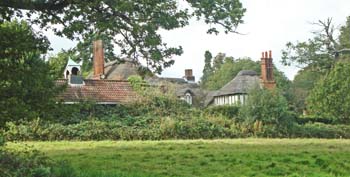
The Cottage, Lady Isabella's residence,seems to be the only surviving building of the Colony.
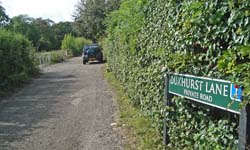
The east drive off Reigate Road.

The west drive from Crutchfield Lane.
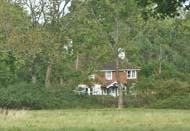
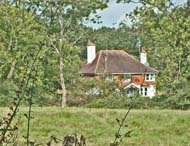
A house on Duxhurst Lane, but probably not part of the original Colony.
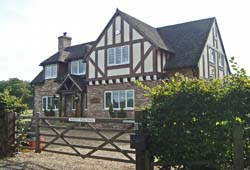
Duxhurst Farm House is built in the timbered style of the Colony's cottages.

Sidlow Manor, with solar panels on its roof, is probably on the site of the Manor House.
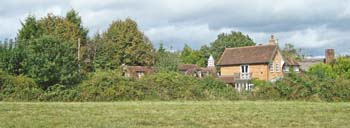
A group of new houses now occupy the site (above and below).

Aslet C 2010 Duxhurst. In: The Villages of Britain. The Five Hundred Villages that Made the Countryside. London, Bloomsbury, p. 110.
(Author unstated 1896 The treatment of inebriates. British Medical Journal 2 (1854), 90.
(Author unstated) 1896 The Duxhurst Hospital Home for Lady Inebriates. British Journal of Psychiatry 42, 684.
(Author unstated) 1897 The Duxhurst Farm Colony for Inebriates. British Medical Journal 1 (1886), 483-484.
(Author unstated) 1899 The Inebriates Act. British Medical Journal 2 (2009), 27-28.
(Author unstated) 1900 The Colony for Inebriate Women, Duxhurst. An interesting experiment. The Quiver 1, 376.
(Author unstated) 1900 Women inebriates. And what Lady Somerset has done for them. Lewiston Daily Sun, 20th November, 2.
(Author unstated) 1901 Farm colony for inebriate women. Wanganui Chronicle, 25th July, 2.
(Author unstated) 1902 Some statistics and a moral. British Journal of Medicine 1 (2142), 160.
(Author unstated) 1903 Inebriate Retreat. A Home that is successful. West Gippsland Gazette, 15th September, 3.
(Author unstated) 1904 Outside the gates. Women. British Journal of Nursing, 19th March, 287.
(Author unstated) 1915 Into a quiet haven. Nelson Evening Mail, 16th July, 3.
(Author unstated) 1917 The Duxhurst Children's Village. British Journal of Nursing Supplement, 19th August, 112.
(Author unstated) 1917 The Babies' Haven, Duxhurst. British Journal of Nursing, 8th September, 150-151.
(Author unstated 1918 Saving infant life at Duxhurst. British Journal of Nursing, 23rd February, 137.
(Author unstated) 1921 Death of Lady Somerset. Good Health 19 (April), 13.
(Author unstated) 2009 The Industrial Farm Colony at Duxhurst. Horley Local History Society News (April), 4.
Black R 2011 Duxhurst - Surrey's Lost Village. Arbe Pubications.
Field J 2013 Women and labour colonies (8th March).
Lord JR 1920 The Story of the Horton (Co. of London) War Hospital: Epsom. Its Inceptions and Work and Some Reflections. London, W. Heinemann.
Peyton AL 1983 Nightingale of the North. St John's, Newfoundland, self-published.
Somerset LH 1912 The Duxhurst Industrial Farm Colony for Female Inebriates. British Journal of Inebriety 10, 81-85.
http://archive.is
http://paperspast.natlib.govt.nz
http://rosblackcreative.com
http://topfoto.co.uk (1)
http://topfoto.co.uk (2)
www.british-history.ac.uk
www.diomedia.com
www.facebook.com
www.geograph.org.uk
www.gracesguide.co.uk
www.reigatehistory.co.uk (1)
www.reigatehistory.co.uk (2)
www.southwark.anglican.org
www.thegazette.co.uk
Return to alphabetical list
Return to home page